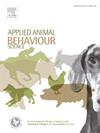I spy with my little eye: Humans follow a horse-specific visual search pattern when examining facial expressions of horses with different levels of pain
IF 2
2区 农林科学
Q1 AGRICULTURE, DAIRY & ANIMAL SCIENCE
引用次数: 0
Abstract
In daily interaction with horses, humans primarily rely on facial expression as a non-verbal equine cue for emotional information. Difficulties in correctly recognizing these signals might arise due to the species-specificity of facial cues, possibly leading to diminished equine welfare and health. This study aimed to explore human visual search patterns when assessing equine facial expressions indicative of various pain levels, utilizing eye-tracking technology. Hundred and eight individuals (N = 108), classified into three groups (affinity with horses (N = 60), pet owners with no affinity with horses (N = 32), and individuals with no affinity with animals (N = 16)) participated in the study; with their eye movements recorded using eye tracking glasses they evaluated four photos of horses with different levels of pain. Error score, calculated by comparing participant scores to Gold Standard Visual Analogue Score levels and fixation metrics (number of fixations and duration of fixations) were analysed across the four photos, participant group and Areas of Interest (AOIs): eyes, ears, nostrils, and mouth. Statistical analysis utilized linear mixed models. Highlighting the critical role of the eyes as key indicators of pain, findings showed that the eyes played a significant role in assessing equine emotional states, as all groups focused on them for a longer time and more frequently compared to other facial features. Also, participants showed a consistent pattern in how they looked at a horse's face, first focusing on the eyes, then the ears, and finally the nose/mouth region, indicating a horse-specific pattern. Moderate pain was assessed with similar accuracy across all groups, indicating that these signals are broadly recognizable. Nevertheless, non-equestrians faced challenges with recognizing the absence of pain, possibly highlighting the role of experience in interpreting subtle equine expressions. The study's limitations, such as variability in assessment conditions may have impacted findings. Future work could further investigate why humans follow this visual search pattern and whether they recognize the significance of a horse's ears. Additionally, emphasis should be placed on developing targeted training interventions to improve equine pain recognition, possibly benefiting equine welfare and health.
我用我的小眼睛窥探:当观察不同程度疼痛的马的面部表情时,人类会遵循一种特定于马的视觉搜索模式
在与马的日常互动中,人类主要依靠面部表情作为非语言的情感信息线索。由于面部线索的物种特异性,正确识别这些信号可能会出现困难,这可能导致马的福利和健康下降。本研究旨在利用眼动追踪技术,探索人类在评估马不同疼痛程度的面部表情时的视觉搜索模式。108人(N = 108)被分为3组(与马有亲和关系的人(N = 60),与马没有亲和关系的宠物主人(N = 32),与动物没有亲和关系的人(N = 16))参与了研究;通过眼动追踪眼镜记录下他们的眼球运动,他们评估了四张不同程度疼痛的马的照片。通过比较参与者得分与金标准视觉模拟得分水平和注视指标(注视次数和注视持续时间)来计算误差分数,分析了四张照片、参与者组和感兴趣区域(AOIs):眼睛、耳朵、鼻孔和嘴巴。统计分析采用线性混合模型。研究结果强调了眼睛作为疼痛的关键指标的关键作用,研究结果表明,眼睛在评估马的情绪状态方面发挥了重要作用,因为与其他面部特征相比,所有组的马都花了更长的时间和更频繁地关注眼睛。此外,参与者在看马的脸时表现出了一致的模式,首先关注马的眼睛,然后是耳朵,最后是鼻子/嘴巴区域,这表明了马特有的模式。所有组对中度疼痛的评估准确度相似,表明这些信号是广泛可识别的。然而,不骑马的人在认识到没有疼痛时面临挑战,这可能突出了经验在解释马的微妙表情中的作用。该研究的局限性,如评估条件的可变性可能影响了研究结果。未来的工作可以进一步研究为什么人类会遵循这种视觉搜索模式,以及他们是否认识到马耳朵的重要性。此外,重点应该放在发展有针对性的训练干预措施,以提高马的疼痛识别,可能有利于马的福利和健康。
本文章由计算机程序翻译,如有差异,请以英文原文为准。
求助全文
约1分钟内获得全文
求助全文
来源期刊

Applied Animal Behaviour Science
农林科学-行为科学
CiteScore
4.40
自引率
21.70%
发文量
191
审稿时长
18.1 weeks
期刊介绍:
This journal publishes relevant information on the behaviour of domesticated and utilized animals.
Topics covered include:
-Behaviour of farm, zoo and laboratory animals in relation to animal management and welfare
-Behaviour of companion animals in relation to behavioural problems, for example, in relation to the training of dogs for different purposes, in relation to behavioural problems
-Studies of the behaviour of wild animals when these studies are relevant from an applied perspective, for example in relation to wildlife management, pest management or nature conservation
-Methodological studies within relevant fields
The principal subjects are farm, companion and laboratory animals, including, of course, poultry. The journal also deals with the following animal subjects:
-Those involved in any farming system, e.g. deer, rabbits and fur-bearing animals
-Those in ANY form of confinement, e.g. zoos, safari parks and other forms of display
-Feral animals, and any animal species which impinge on farming operations, e.g. as causes of loss or damage
-Species used for hunting, recreation etc. may also be considered as acceptable subjects in some instances
-Laboratory animals, if the material relates to their behavioural requirements
 求助内容:
求助内容: 应助结果提醒方式:
应助结果提醒方式:


